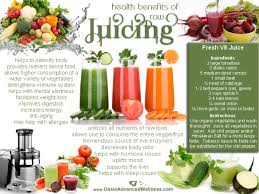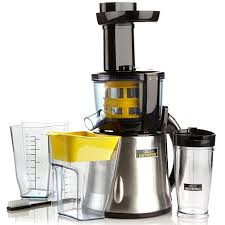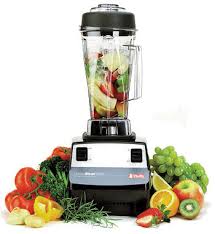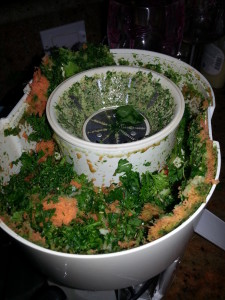Juicing vs. Smoothies

 JUICING VS. BLENDING: WHICH ONE IS BETTER?
JUICING VS. BLENDING: WHICH ONE IS BETTER?
Here is a short comparison that explains the differences between the two as well as some of the specific benefits of each.
What’s The Difference?
JUICING
Without all the fiber, your digestive system doesn’t have to work as hard to break down the food and absorb the nutrients. In fact, it makes the nutrients more readily available to the body in much larger quantities than if you were to eat the fruits and vegetables whole.This is especially helpful if you have a sensitive digestive system or illness that inhibits your body from processing fiber. The fiber in produce helps slow down the digestive process and provides a steady release of nutrients into the blood stream. Jason Vale calls juicing “A nutrient express!” Freshly squeezed vegetable juices form part of most healing and detoxification programs because they are so nutrient rich and nourish and restore the body at a cellular level.
A word of caution: When you remove the fiber from the produce, the liquid juice is absorbed into your blood stream quickly. If you are only juicing fruits, this would cause a rapid spike in blood sugar and unstable blood sugar levels can lead to mood swings, energy loss, memory problems and more!
Fiber is also filling and without fiber in the juice, some people tend to get hungry again quickly.
Smoothies
Unlike juices, smoothies consist of the entire entire fruit or vegetable, skin and all and contain all of the fiber from the vegetables.
However, the blending process breaks the fiber apart (which makes the fruit and vegetables easier to digest ) but also helps create a slow, even release of nutrients into the blood stream and avoids blood sugar spikes. Smoothies tend to be more filling, because of the fiber, and generally faster to make than juice, so they can be great to drink first thing in the morning as your breakfast, or for snacks throughout the day.
By including the fiber in your smoothie, the volume will increase. Also, you can pack more servings of fruits and veggies into a single serving of juice than you can into a smoothie.
1. It’s best not to combine fruits and vegetables (unless it’s apple). This can affect how well your digestive enzymes function.
This doesn’t seem to matter too much in green juices and smoothies, but vegetables like carrots, beetroots, broccoli and zucchini don’t combine well with fruit due to their high starch content. In his book Food Combining Made Easy, Dr. Herbert Shelton explains that starchy foods have to be eaten alone because starches are digested with enzymes different from those used for any other food group. Combining starchy foods with fruit may cause fermentation and gas. However, Dr. Shelton found that green leafy veggies combine well with pretty much everything.
2. Try to drink your juice or smoothie straight away. After 15 minutes, light and air will destroy much of the nutrients. If you can’t drink it straight away, transfer to a dark airtight container until you’re ready.
Using The Right Equipment
To get the most benefit from your juices and smoothies, it’s important to use the right equipment. Invest in a good-quality juicer. Cheaper, centrifugal juicers introduce heat and oxygen and destroy the enzymes and nutrients in your fruits and vegetables. While it may cost you a bit more initially, a premium cold-press juicer will produce a superior-quality juice and allow you to extract more from your fruit and vegetables, saving expense in the long-term.
The machines themselves will also generally last longer. In contrast to the rough extraction of centrifugal juicers, mastication or cold-press juicers compress fruit and vegetables to ‘squeeze’ out their juice.
The same goes for a blender. You want a blender that is gentle on your produce and doesn’t heat up the enzymes as it’s pulling apart the fibers. We spend money on gadgets, clothes, restaurants and other luxuries so, if you can afford it, investing in your health by buying a quality juicer or blender is totally worth it.
What Should I Look For
In A Juicer?
When we are looking for our perfect juicer here is what we look for: (Great source for this info was http://www.foodmatters.tv/juicer-buying-guide)
Centrifugal Juicers
Centrifugal juicers are commonly available in retail outlets and are the cheapest type to purchase. These machines initially extract juice by pulverizing fruit and vegetables against a round cutting blade that spins very quickly against a metal strainer. The centrifugal force generated by the spinning motion of the cutting surface separates the juice from the pulp.
- Pros: Cheaper
- Con: Not the best way to extract juice because heat may destroy nutrients.
Cold Press Juicers
These machines operate via a masticating (chewing) or cold press method to produce a superior juice to their centrifugal counterparts. In contrast to the rough extraction and high speeds of centrifugal juicers, cold press juicers operate at lower speeds and gently compress fruit and vegetables to ‘squeeze’ out their juice. While more costly, their slower and more thorough extraction rates produce a higher-quality juice, and more of it.
- Pro: Higher juice yield
- Con: Expensive
BLENDERS
Blenders are coming out of the pantries and being used as a great way to add more fruits and vegetables to your diet. Plus, it doesn’t “waste” the pulp as it is finely shredded/blended into an easily drinkable form. I know a lot of people who prefer to juice this way. They add ice and protein powders and make a pretty delectable smoothie. I wrote a blog post about Andrea who has lost 60 pounds using this kind of method to drink her veggies and fruit. She uses a Nutribullet and adds ground up flax seeds. Just looking at her you can tell it works as far as weight loss.
- Pro: Uses all of the vegetables and fruit (no left over pulp)
- Con: Assimilation of micronutrients are slowed down because it requires more of the digestive process
What to look for when choosing a juicer
- Able to easily juice all greens, herbs and grasses (with a high yield)
- Good to juice fruits, including soft varieties
- Cold pressed, to produce a superior juice
- Low speed (rpm), to minimize oxidation and produce a longer lasting juice
- Able to make nut milks
- Easy to clean
- Low noise!
Source Links:
http://www.thewellnesswarrior.com.au/2011/08/juicing-versus-blending/.
http://www.drsearswellnessinstitute.org/blog/2012/04/12/juicing-vs-blending/





 D5 Creation
D5 Creation